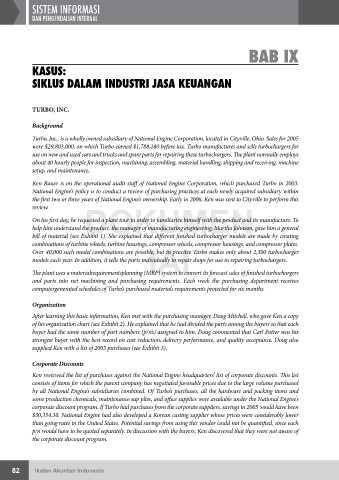Page 91 - Modul CA - Sistem Informasi dan Pengendalian Internal (Plus Soal)
P. 91
SiStem informaSi
dan Pengendalian internal
BAB IX
KASUS:
SIKLUS DALAM INDUSTRI JASA KEUANGAN
TURBO, INC.
Background
Turbo, Inc., is a wholly owned subsidiary of National Engine Corporation, located in Cityville, Ohio. Sales for 2005
were $29,803,000, on which Turbo earned $1,788,180 before tax. Turbo manufactures and sells turbochargers for
use on new and used cars and trucks and spare parts for repairing these turbochargers. The plant normally employs
about 40 hourly people for inspection, machining, assembling, material handling, shipping and receiving, machine
setup, and maintenance.
Ken Bauer is on the operational audit staff of National Engine Corporation, which purchased Turbo in 2003.
National Engine’s policy is to conduct a review of purchasing practices at each newly acquired subsidiary within
the first two or three years of National Engine’s ownership. Early in 2006, Ken was sent to Cityville to perform this
DOKUMEN
review.
On his first day, he requested a plant tour in order to familiarize himself with the product and its manufacture. To
help him understand the product, the manager of manufacturing engineering, Martha Johnson, gave him a general
bill of material (see Exhibit 1). She explained that different finished turbocharger models are made by creating
IAI
combinations of turbine wheels, turbine housings, compressor wheels, compressor housings, and compressor plates.
Over 40,000 such model combinations are possible, but in practice Turbo makes only about 2,300 turbocharger
models each year. In addition, it sells the parts individually to repair shops for use in repairing turbochargers.
The plant uses a materialrequirementsplanning (MRP) system to convert its forecast sales of finished turbochargers
and parts into net machining and purchasing requirements. Each week the purchasing department receives
computergenerated schedules of Turbo’s purchased materials requirements projected for six months.
Organization
After learning this basic information, Ken met with the purchasing manager, Doug Mitchell, who gave Ken a copy
of his organization chart (see Exhibit 2). He explained that he had divided the parts among the buyers so that each
buyer had the same number of part numbers (p/n’s) assigned to him. Doug commented that Carl Potter was his
strongest buyer with the best record on cost reduction, delivery performance, and quality acceptance. Doug also
supplied Ken with a list of 2005 purchases (see Exhibit 3).
Corporate Discounts
Ken reviewed the list of purchases against the National Engine headquarters’ list of corporate discounts. This list
consists of items for which the parent company has negotiated favorable prices due to the large volume purchased
by all National Engine’s subsidiaries combined. Of Turbo’s purchases, all the hardware and packing items and
some production chemicals, maintenance sup plies, and office supplies were available under the National Engine’s
corporate discount program. If Turbo had purchases from the corporate suppliers, savings in 2005 would have been
$30,354.30. National Engine had also developed a Korean casting supplier whose prices were considerably lower
than going rates in the United States. Potential savings from using this vendor could not be quantified, since each
p/n would have to be quoted separately. In discussion with the buyers, Ken discovered that they were not aware of
the corporate discount program.
82 Ikatan Akuntan Indonesia

